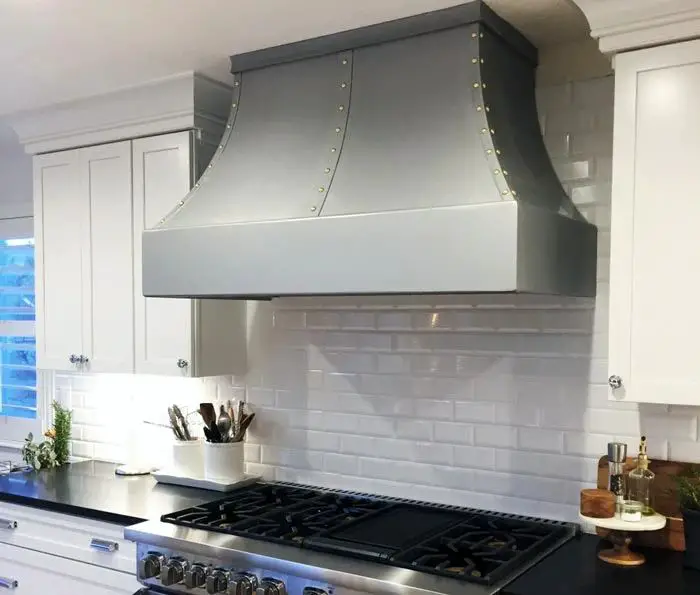Covering an existing range hood is often desired for aesthetic or functional reasons. The range hood is a vital kitchen appliance for ventilation, but its appearance may not suit your kitchen decor or it may be noisy. Concealing the range hood offers a quick update without a major renovation. Here are some key considerations when deciding whether and how to cover your current range hood.
Page Contents
What Are the Requirements for Range Hood Ventilation?
While covering a range hood can improve its appearance, it’s critical not to compromise the ventilation. There are guidelines for proper venting that must be maintained:
- The range hood should vent to the exterior. Recirculating the air through filters is not enough.
- The hood should project at least 3 inches past the front of the cooking surface.
- For a 30-inch range, the hood should be 30 inches wide minimum. It is recommended to match the hood width to the range width.
- The bottom of the hood should be 24-30 inches above the cooking surface.
- The hood must move a minimum amount of air – 100 CFM for domestic hoods or more for commercial. Higher CFM ratings improve ventilation.
If your current hood meets these requirements, then covering it may be possible by building a facade around the hood rather than replacing it. But first, assess the condition of your current range hood.
Evaluate the Condition of Your Range Hood
Your range hood needs to be in good working order if you plan to keep it. Check these points:
- There should be no rattling, humming or vibration noises when the fan is on. Bearings may need replacement.
- The fan blades should still have their full width with no cracks, warps or accumulation of grease. Clean or replace if needed.
- Spin the fan blades by hand when off. They should have minimal resistance and spin smoothly.
- The lights (if present) should all activate properly.
- There should be no smells of gas or other leakage detected.
- The hood should be structurally sound with proper mounting and no damage.
Trying to conceal a range hood in poor condition will likely lead to more headaches down the road. If the unit is faulty, a full replacement may be the wiser option.
How to Cover a Wood Range Hood
If your range hood has a wooden underside, this can easily be covered by adding panels or tiles:
- Measure the underside surface area of the hood that you want to cover. Cut panels to size from material like beadboard, tiles, metal, etc.
- Use adhesive and/or small finishing nails to attach panels. Follow manufacturer’s instructions.
- Use trim pieces around the edges for a finished look. CAulk or grout seams as needed.
- Prime and paint if using raw wood panels. Or apply backsplash tile, wallpaper, etc. to customize the look.
- Make sure to leave access for lightbulbs, filters and fans. Do not cover openings.
This is a relatively easy way to refresh the look. Make sure any finish materials are heat-resistant if near the cooking surface.
Covering a Stainless Steel Hood
Stainless steel hoods have a very different look than wood. Here are some methods to conceal a stainless steel range hood:
- Build a wooden box frame that fits around the hood’s dimensions. Attach with cleats so it can be removed. Finish the exterior to blend with cabinets.
- Construct panels to fit inside the hood’s body, behind the filters. Finish them with tile, metal, wallpaper etc. Remove to access interior.
- Fabricate a metal cover that slides over the hood structure. Use nickel, copper or colored metal for desired look.
- Install a new hood facade around the original hood. Leave proper clearances for ventilation.
Professional help may be needed for fabrication. Make covers easily removable for maintenance access. Take care not to cover required venting.
Building a Range Hood Cover Enclosure
For a built-in look, you can box in the range hood using these basic steps:
- Build a frame to fit around the hood using 2×4 lumber. Attach to the ceiling and cabinetry to support. Allow proper ventilation space.
- Hang new cabinet doors below the hood to hide the body.
- Construct side panels and an overhang above the hood. Use moisture-resistant drywall.
- Finish the enclosure with molding and trim to match cabinets.
- Prime and paint or apply facing like tile or wallpaper.
- The range hood controls can remain on the front or be moved to a cabinet face.
- Make sure to leave access for maintenance and cleaning.
This approach takes more effort but makes the range hood nearly disappear. Match to your cabinetry for a seamless look.
Important Considerations When Covering a Range Hood
Here are key factors to keep in mind with any range hood concealment project:
- Venting: Never cover or restrict airflow from vents or the ductwork leading outside.
- Filters: Easy access must be maintained to remove filters for cleaning.
- Electrical: Don’t cover any electrical components and leave access for maintenance.
- Lights: Leave lights uncovered and usable. Or install new lighting externally.
- Dimensions: Don’t reduce the size of the hood or lose needed overhead clearance.
- Materials: Use appropriate nonflammable materials resistant to heat and grease buildup.
- Removable covers: All concealment elements should be easily removable for hood access.
Careful planning is needed to avoid safety hazards or reduction in hood performance when adding range hood covers. Prioritize ventilation requirements before aesthetic improvements.
Conclusion
Covering an existing range hood allows you to update the look without replacing the entire unit. But ventilation and accessibility cannot be compromised. Assess your current hood condition and craft concealment options that are removable for cleaning access. With smart design integrated with your cabinetry and decor, you can refresh the kitchen aesthetic while responsibly maintaining this important appliance.
